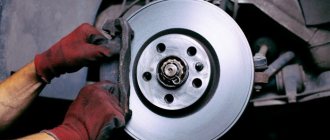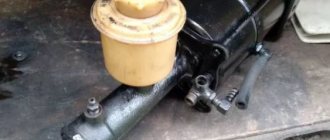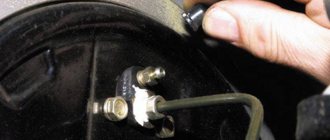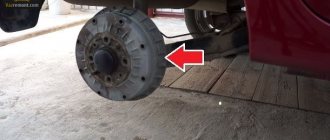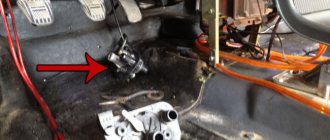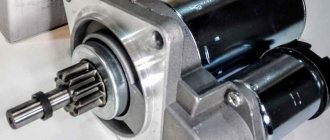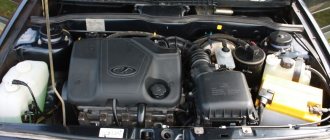The braking system in cars of the VAZ family is one of the most important components, due to the fact that we are talking about the safety of not only the driver, but also other road users. A typical diagram of the VAZ 2109, 2110-2114 car system is shown in the figure:
Reasons for a drop in brake fluid level:
- Reducing the thickness of the friction linings of the brake pads.
- Worn end seal of the master cylinder.
- Wear of the cuffs of the working cylinders of the front or rear wheels.
- Liquid leakage through torn hoses.
- Leak through leaks at joints.
It is quite easy to detect the location of the leak due to the fact that the brake fluid leaves characteristic stains when it flows out. For example, if there is a leak through the working cylinders, traces of fluid can be found on the front wheel calipers or on the rear wheel brake drums. Moreover, to diagnose the location of the leak, you often don’t even need to remove the wheels.
There may be several reasons leading to fluid leakage around the front or rear wheels, the main ones being:
- Leaky connection of hydraulic tubes to the mechanism;
- Wear (scratches, risks) of the “mirror” of the brake cylinders;
- Wear of rubber sealing cuffs.
To identify and eliminate these faults, you need to lift the rear of the car and remove the wheel. Then you need to remove the brake drum, after unscrewing the two guide pins for the wheel.
TIP: As a rule, due to wear on the inner surfaces of the drums, it becomes difficult to remove them. There are two ways to solve the problem
The first method is to knock down the drum by striking its diametrically opposite internal parts, and it is recommended to use a RUBBER hammer; a metal hammer cannot be used, since there is a high probability of damage to the brake drums.
The second method is based on the principle of “squeezing” the drum from the hub. For this purpose, the drums have two threaded holes. You need to select two bolts of sufficient length and screw them into the holes until they stop and then continue to screw them in one at a time until the brake drum is removed.
After this, you need to unscrew the hydraulic tube from the brake mechanism. To do this, you need to use a special wrench (see photo): To avoid unnecessary loss of liquid, it is advisable to plug the free end of the tube using a wooden plug of a suitable diameter, or a piece of plastic film wrapped around the tube and tied with any elastic band.
TIP: The most optimal solution to the problem would be to replace the complete brake cylinder of a VAZ car. If this is not possible, then it is necessary to replace the worn parts of the old cylinder.
First, you need to remove the anthers on both sides. Then carefully use pliers with narrow jaws to pull out the pistons along with the rubber seals, each in its own direction. After this, it is necessary to inspect all parts for wear.
IMPORTANT! Before installing the drum, you must thoroughly clean all friction surfaces of brake fluid residues. To do this, you can use a rag soaked in white spirit.
Finally, it is necessary to remove air from the system. The method of “bleeding” the brake circuit of VAZ cars is described in detail in the literature and is not particularly difficult.
Fluid leakage from the front wheels is eliminated by analogy with the rear mechanisms. There is a difference in the design of the front brakes depending on the brand of car. So, for example, in the “classic” 2107, the caliper is a device consisting of two halves, each with its own pistons installed.
This design is quite complex due to the fact that the number of possible faults doubles. Therefore, unlike the VAZ 2107, more modern Ladas (2109, 2112, 2114, etc.) are equipped with self-centering calipers, which have only one piston. In this regard, when repairing a VAZ 2107 (and similar ones), it is also necessary to disassemble the caliper into two halves and replace the worn parts on each half, and then assemble the caliper.
Very often, fluid escapes through cracks in brake hoses, which become unusable due to difficult operating conditions, as well as due to the natural aging of the materials from which they are made. Front brake hoses that are damaged, even on the outer layer, must be replaced. Dismantling the hoses begins by unscrewing the end that is screwed to the system tube. To do this you will need two wrenches. Holding the brake hose with one wrench and thus preventing it from turning with a second wrench, unscrew the sliding nut located on the tube.
After disconnection, it is necessary to plug the free end of the tube using any method described above. The second end of the hose is unscrewed from the front wheel brake mechanism. The new hose is installed in the reverse order of removal, after which it is necessary to remove air from the system.
A drop in the brake fluid level due to a malfunction of the master cylinder cuffs.
To resolve this problem you must
- Use a syringe to pump out as much liquid as possible from the tank; this can be done using a syringe without a needle by unscrewing the tank cap.
- Disconnect the exhaust pipes from the brake master cylinder
- Unscrew the brake master cylinder from the brake master cylinder body
After this, using pliers to remove the thrust rings, remove the ring from the inside of the cylinder, carefully remove the pistons of the first and second brake circuits and the springs. After inspecting the inner surface of the cylinder for damage and traces of corrosion (if any, replace it) and replacing the sealing collars, thoroughly cleaning all parts of dirt and using fresh brake fluid, assemble the master brake cylinder. In this case, you must be very careful not to confuse the sequence of installation of components.
How to tell if brake fluid is leaking
You can recognize a leak in the brake system by the fluid level in the reservoir. If its level approaches the minimum mark, then a leak occurs. Also, the “!” indicator should light up on the dashboard, indicating a critical lack of fluid for the brake system. But this does not always happen, so you need to control the level manually.
You can accurately understand that there is a fluid leak by making a test top-up in the expansion tank. If after this there is a sharp drop in its level, then the brake fluid leaves.
First of all, in such a situation, you need to check the expansion tank itself for cracks. If they are, the brake fluid tank must be replaced.
Diagnostic features
The first thing you need to pay attention to is the readings on the dashboard. As a rule, they react to a malfunction earlier than you are able to diagnose it during operation. So, if there are problems in the brake system, then the corresponding lamp should light up on the dashboard.
When the first signals of a malfunction appear in the brake system, the first thing you need to pay attention to is inspecting the brake cylinder (there should be no obvious signs of leakage on it).
In addition, pay attention to each of the brake circuit outputs, joints, and so on. After an external inspection, check the pressure in the brake system (this can be done using a special pressure gauge).
The pressure obtained during the measurement process is compared with what the car manufacturer recommends. If the measurements show a serious difference, then we can talk about the failure of one of the circuits. It is also worth checking the tightness of the circuit, but this work can only be done with special equipment.
As practice shows, one of the main reasons for the breakdown of the gas turbine engine is its depressurization. This is easy to notice by the appearance of a leak and a characteristic odor. Damage to the housing, failure of the return spring, wear of the cuffs (sealing and inlet) or the assembly mirror - all this is a reason to replace the master cylinder.
Knowing how to identify a faulty brake master cylinder can help you identify the problem early, fix it, and eliminate any risk to life. Good luck on the roads and of course no breakdowns.
Problems that arise with the brakes while traveling are considered critical and must be corrected immediately. The culprit of the malfunction is often the main cylinder, installed in the engine compartment and rigidly connected to the pedal. To find out the cause of the breakdown and repair the unit yourself, you need to know the structure of the brake master cylinder (MBC) and its principle of operation. During the diagnostic process, it is necessary to distinguish and filter out problems with other elements of the system.
Vulnerabilities of the VAZ 2114
The most vulnerable points in the VAZ 2114 brake system include:
- Master brake cylinder - most often, leakage occurs due to wear of the sealing collar, which is subjected to stress during operation. There are also cases of installation of initially poor-quality seals. Detecting this leak is the most problematic, since liquid can go into the vacuum booster. In this case, no leaks are formed. If there are leaks on the left CV joint and gearbox, the GTZ is leaking.
- Brake cylinders of the rear wheels - in the VAZ 2114 their cuffs are susceptible to destruction, especially in frosty weather. A leak is determined by the presence of traces of leaking brake fluid on the calipers. If there is a strong leak, there may be marks under the wheels and on the road surface.
- Brake hoses - they are also subject to mechanical damage. If the rubber is dry, cracks will form on it. You should also inspect for leaks.
Symptoms of problems
The fluid brake system consists of many parts that can become unusable: pipes, wheel cylinders, calipers, drums and pads. Typical signs of a faulty master cylinder:
- After pressing the pedal, the car stops slowly. The reason is that the cuffs of one or two pistons have lost their tightness - they have cracked or “floated”.
- To slow down, you need to press the brake pedal hard. The phenomenon occurs due to swelling of the rubber of the piston seals.
- The brake pedal travel is too short. The fluid inside the cylinder has nowhere to go because the compensation hole is clogged. Another option is that the passage is blocked by a swollen rubber seal.
- A common symptom is pedal failure, the brakes coming on at the end of the stroke. This indicates complete wear of the cuffs; as a result, liquid penetrates behind the piston and rushes into the expansion tank - the cylinder “bypasses.”
- The pads do not release the brake discs and drums and get very hot when driving. Options: one of the pistons is jammed or the bypass hole is clogged.
The listed symptoms of a GTZ malfunction are similar to malfunctions of other elements. Pedal failure also occurs when a large amount of air enters the tubes or loss of fluid in one of the working cylinders. Sluggish deceleration and increased force on the pedal are often caused by a breakdown of the vacuum booster - a cracked membrane or a lack of tightness at the joints of the hose that takes off engine vacuum.
There are signs that clearly indicate the performance of the main hydraulic cylinder and the malfunction of other elements:
- during braking, the car pulls to the side - the problem lies in a certain circuit or wheel;
- jamming of the brake mechanisms of one wheel;
- creaking and squeaking when braking;
- heating the discs and pads on one wheel.
If you eliminate these symptoms, it will become easier to check the brake master cylinder in a garage. This also includes obvious brake fluid leaks and the knocking sound of worn calipers.
How to find the cause of the leak
To find where the VAZ 2114 brake fluid goes, you should conduct a thorough visual inspection.
Brake hoses
The easiest way to detect a leak is on the brake hoses - here it is enough to check the rubber by touch. If it is rigid, inelastic and cracks form when bent, the hose must be replaced, even if there are no leaks.
Sometimes a brake hose of the wrong diameter falls off the fitting. In this case, it should be replaced with a similar one, but smaller in diameter. You can put on the same hose, but in this case you will have to secure it with special clamps.
Wheel brake cylinders
To detect fluid leaks on the brake cylinders, remove the wheels and inspect the brake system for signs of leakage on the calipers.
VAZ-2114 is equipped with a drum braking system. To detect leaks in the wheel cylinders, the brake drums must also be removed. This usually causes difficulty in removal due to the fact that their surface wears out.
In this case, they are removed in two ways:
- You can “squeeze” the drum out of the hub by selecting bolts of the required diameter and screwing them into the threaded holes on the drum. This is done until the drum is removed.
- Knock out the brake drum by hitting its internal parts with a hammer from opposite sides.
Important! With the second method, you should only use a hammer with a rubber striker. Metal cannot be used, because The drum may be damaged.
The best option for the VAZ-2114 is to replace the entire brake cylinder assembly at once. Otherwise, you should disassemble the cylinder and inspect its parts for damage.
You need to carefully examine:
- the surface of the cylinder itself;
- pistons - need to be changed if there are signs of corrosion or scratches on them;
- seals - if worn or in case of a loose fit, they should be replaced;
- Anthers - check for rips, scratches, cuts and other damage.
Attention! Before assembly, all cylinder parts should be cleaned and washed with brake fluid.
Master brake cylinder
If the cuffs of the main brake cylinder are clearly worn out, they should be replaced.
- pump out as much liquid as possible from the tank with a syringe;
- disconnect all tubes from the cylinder;
- remove and disassemble the cylinder itself.
It is necessary to carry out an inspection similar to the inspection of wheel cylinders. Brake circuit pistons must be free of corrosion and other damage.
If the surface of the cylinder itself has mechanical damage, the entire assembly must be replaced. The sealing collars should fit snugly and not be scratched or cracked.
After replacing components, you should:
- add brake fluid to the reservoir to the maximum;
- Bleeding the brake system is a mandatory requirement, since after repair work there is air in it.
Thus, a VAZ 2114 brake fluid leak is a problem that will not be difficult to solve for an experienced car enthusiast.
REPLACEMENT PROCESS
Before starting work, you need to stock up on the following tools:
- Hose 10-15 centimeters long and 6 mm in diameter;
- Wrenches for 8 and 10;
- Plastic bottle;
- Gloves (work clothes and safety glasses are also a good idea);
- Hydraulic fluid (there are a lot of manufacturers, each with its own characteristics).
Having collected all the tools, you can start working. The procedure is not complicated and does not require any professional skills. Most motorists do the replacement themselves.
It is extremely difficult to do this kind of work alone, so I recommend taking a friend with you who will undoubtedly help in the process. This will not only save time, but will also greatly simplify the procedure.
We are changing bunker - 4 in the VAZ 2114 in stages:
- We park the car on a pit or overpass;
- Remove the cap from the brake reservoir;
- We go into the pit. Here we need a fitting located on the rear right wheel;
- It is closed with a cap, which we remove;
- Take a bottle and pour some DOT-4 into it;
- We put the hose on the fitting and lower the other end into the bottle (do not forget to lower it to the bottom);
- Now you need someone to press the brake pedal. Smoothly 7-8 times in a row, and the last press all the way and hold;
- Unscrew the fitting a couple of turns;
- We observe how the waste product comes out;
- When 1-1.5 centimeters remain in the tank (it is important not to be late, otherwise air will enter the system), tighten the fitting and release the pedal;
- Add the missing DOT-4 to the tank (up to the Maximum mark);
- Then we repeat the procedures with the fitting and pressing the pedal until clean pillbox flows into the bottle;
- We tighten the fitting and move on to the next wheel.
There is a specific order in which the replacement must be performed. After the left rear wheel, we need the right front, then the left rear and finally the right front. If you started doing everything according to the instructions, then this is the sequence in which the bunker runs.
Where does the brake fluid go?
The presence of brake fluid (BF) can be determined by the level in the reservoir. It is advisable that the TJ is always at the max mark. If you notice that the fluid level is dropping, make sure that it does not drop below the minimum. To be on the safe side, a red exclamation mark will light up on the central panel inside the car (most often this happens when braking).
If the TJ level decreases, you need to do the following:
- top it up;
- At the first opportunity, find and replace the faulty element of the brake system.
Vulnerable spots of the car
The brake cylinder (TC) is leaking. To find it, you need to remove the wheels and inspect the front discs for leaks from the caliper; on the rear wheels you also need to remove the drum. Most often, the rear TC fails due to poor-quality rubber seals. And such problems, as a rule, begin in cold weather (How to replace the rear brake cylinder?).
The main cylinder of the brake unit (GTC) has leaked. It is necessary to conduct an external inspection to look for smudges. Most often, the GTZ leaks precisely because of the rubber seal closest to the vacuum booster. The fuel fluid from the GTZ flows onto the gearbox, then flows onto the left CV joint. But it may also be that the GTZ flows into the vacuum chamber without external leaks. This can only be discovered by removing the GTZ.
The brake hose is leaking/falling off. Again, the malfunction is determined by visual inspection for the presence of smudges. The hose could fly off the caliper itself, leak at the joints, or burst.
Therefore, first, evaluate the condition of the pipes and cylinders on the calipers, and then proceed to the main one.
If you find a malfunction, carry out repair work and replace parts if necessary. Then be sure to bleed the brakes, as there will be air in the system. Also, do not forget that brake fluid is hygroscopic and requires regular replacement (How often do you change brake fluid?).
Source
Dismantling
To carry out dismantling work that entails replacing the master brake cylinder, it is necessary to prepare a certain set of tools and materials. It includes:
- Brake fluid;
- Tool for unscrewing fittings;
- Pliers;
- Dry rags;
- Metal brush for cleaning contacts;
- Key for 17, 13 and 10 millimeters;
- Spring tensioner;
- New brake cylinder.
Before starting work, prepare yourself a site where you can place all the elements to be removed. Write down or photograph, or otherwise record where this or that unit was removed from. This will greatly simplify the reassembly procedure.
After all the preparatory activities, you can start working.
- Be sure to remove the negative terminal from the battery of your VAZ 2114. Without this, almost no repair or maintenance work on the car can begin.
- Raise the hood and lock it securely.
- Use a syringe to remove any remaining brake fluid from the container.
- Unscrew the brake fluid supply pipes using an open-end wrench. Unscrew it carefully so that the brake fluid does not get on other units in the engine compartment.
- In some cases, the thread becomes stuck, making it very difficult to remove. In such a situation, we recommend treating the threads with brake fluid and letting it sit for a while. Then the hoses are removed using a 10 mm wrench.
- If these measures do not help, you will need a special wrench with a clamping bolt and a cap slot. It is attached to a nut, clamped with a bolt and rotates the part.
- After dismantling the brake fluid pipes, be sure to mark them with a marker or corrector so that you know which pipe is connected where during reassembly.
- Now you need to remove the brake master cylinder. To do this, first remove the two main nuts that hold the GTZ to the amplifier.
- That's it, the damaged element can be removed from its seat.
- Clean the installation sites so that there are no problems with the new cylinder in the very first months of operation.
- Follow the reverse assembly sequence so as not to confuse the location of certain elements.
- Do not clamp the brake fluid hoses too tightly, otherwise there is a risk of stripping the threads. Restoring connections is a hassle.
- It is recommended to replace the brake fluid used before repair, and then be sure to bleed the brakes.
- To level up, you will need help, so make an agreement with a friend in advance. One will gently press the brake from inside the car, and the other will wait for brake fluid to start coming out of the holes. At this very moment it will be necessary to return the front tubes to their places.
The structure of the car brake system
The hydraulic brake system consists of a brake master cylinder (MBC), wheel cylinders, brake booster, master cylinder reservoir, circuit lines, hoses and brake pads and discs.
Depressing the brake pedal transfers the load to the brake booster, which moves the master cylinder piston. Excess pressure is created in the system, the fluid moves along the lines, actuates the wheel cylinders, which press the pads against the discs or drums, and the car slows down.
FakeHeader
Comments 11
The piston under the front contour is correct, this is good. How does it work after repair?
I used to like the brakes better))) now they are as sharp as diarrhea
))))) They are as they should be. The same thing happened to me before replacing the front pads and brake discs. As soon as I replaced it, it started to slow down like a stone, you didn’t have time to press the pedal. Previously, we were a little thoughtful, you press the brake and the car slows down. Now you can fly your nose into the steering wheel.
My discs are almost worn out... Well, yes, the brakes are the same for me... It’s so bad... If you press harder, it slows down faster)) plus it squeaks on the UAZ, and it’s in the front... The pads are half worn out
Brake hydraulic system
The brakes on your car use a hydraulic system to operate. To transmit braking power, brake fluid passes through a series of metal lines and rubber hoses that connect the main components of the system. Generally speaking, brake lines connect the master cylinder - the hydraulic pump - to the hydraulic modulator - on vehicles equipped with ABS (anti-lock brake system) - and to the wheel brake assemblies.
These component assemblies, connectors, even lines and hoses are all potential points for leaks.
Typically, you become aware of a potential leak when you see a warning light on your dashboard telling you your brake fluid level is low, or notice a fluid spot on the floor of your parking space, or find that you keep adding fluid to the barrel and it gets low.
Now you need to confirm your suspicions. But modern cars are equipped with complex systems and, of course, they are difficult to diagnose when problems arise. However, you can do a preliminary brake inspection even if you don't know much about cars. Knowing what to check can lead you to the source of the problem.
Here's what you need to check.
Sources of brake fluid leaks
Brake fluid may leak from one (or several) elements of the brake system. May leak:
- brake hose;
- brake pipe;
- tank;
- cylinders;
- places of fastening and connection of the components of the assembly.
Crack in the tank
The fluid level may drop due to mechanical damage to the reservoir. This malfunction is easily identified by a simple inspection: oil leaks are visible. The tank will have to be replaced with a new one, do not be greedy and do not try to solder it.
Depressurization of the brake line
One of the most dangerous breakdowns. It manifests itself simply: when pressed, the pedal goes to the floor almost without resistance, and the car does not noticeably slow down. If this happens to your car, stop immediately. Use the handbrake or use the engine brake. You cannot drive with such a malfunction; you risk your life.
Solution
If your car has such a breakdown, the main thing is to solve it comprehensively. It happens that malfunctions are associated with several reasons at once. If the problem is that the pedal is simply rusty, it needs to be replaced. It is easy to correct the situation by replacing the brake fluid with a higher quality one. By the way, you will have to update the fluid in any case - in order to “update” the entire system. Otherwise, over time, the pedal will definitely begin to fail when pressed.
If cracks appear in the pumps, the brake may also begin to fail. Moreover, even microdamages can be the cause of such a breakdown. So if you want the brake to function and not fail in the middle of the road, you will have to replace everything that has stopped working. It turned out to be enough for me to make one replacement. At this point, the question of why the brake pedal failed was closed. To be convinced, it was enough to just start the engine. No extraneous sounds. And if before the return after pressing was too slow, now everything works perfectly.
Vulnerabilities of the VAZ 2114
The most vulnerable points in the VAZ 2114 brake system include:
- Master brake cylinder - most often, leakage occurs due to wear of the sealing collar, which is subjected to stress during operation. There are also cases of installation of initially poor-quality seals. Detecting this leak is the most problematic, since liquid can go into the vacuum booster. In this case, no leaks are formed. If there are leaks on the left CV joint and gearbox, the GTZ is leaking.
- Brake cylinders of the rear wheels - in the VAZ 2114 their cuffs are susceptible to destruction, especially in frosty weather. A leak is determined by the presence of traces of leaking brake fluid on the calipers. If there is a strong leak, there may be marks under the wheels and on the road surface.
- Brake hoses - they are also subject to mechanical damage. If the rubber is dry, cracks will form on it. You should also inspect for leaks.
About the consequences
There can be many answers to the question of where the brake fluid goes from the reservoir. It can go into the vacuum muffler. This indicates a high percentage of wear on the master cylinder piston cuff. For simple rubber there is nothing terrible about this. Another issue is the accumulation of the product in the form of a dangling layer. This will result in an increase in resistance at high diaphragm speeds. There is an opinion that such a situation simply kills the diaphragm. By changing the cuff, movement will become safe. Sometimes you have to install a repair kit while disassembling the vacuum unit.
Checking the brake fluid level
An experienced driver always checks the level of technical fluids in his car (motor oil, antifreeze and brake fluid) before leaving. We strongly advise all motorists to have such a useful habit. It is not difficult to check the condition of the fuel tank; the tank for it is located immediately under the hood, and there are control marks on the tank. It is believed that it is optimal to fill the liquid to the middle between MAX and MIN.
If this is your first time refilling the fuel tank yourself, be sure to read the instructions for your vehicle. Why is this needed: in some cars, the ABS (anti-lock) system requires bleeding the brakes.
If, when adding fuel oil, you notice a sharp and rapid decrease in the level, this is a reason to look for a leak. Traveling with such a malfunction is strictly prohibited.
In addition to checking the level, it is recommended to check the quality of the liquid. You need to buy a tester and measure the percentage of water in the fuel fluid every six months. An increased indicator indicates that the boiling point of the liquid has decreased (or even reached a critical point, after which the fuel fluid will “boil” and damage the brakes).
When checking the level daily, also monitor the condition of the fuel fluid: there should be no foreign matter, dirt, or deposits on the inner surface of the tank. There should also be no water drops.
Brake fluid can be added, but it is better to change it entirely. Remember that mixing different TJs is not recommended; do not skimp on your safety. The frequency of replacement is indicated in the operating instructions for the technical device. You can do this yourself or at a car service center. Use the fluid recommended by the manufacturer.
What should I put in the tank instead of brake fluid?
I’ll say right away that all fluids are filled just to get to the nearest service station. So, what can you replace the brake fluid with:
- Antifreeze or antifreeze. These fluids are best suited for the brake system. In addition, they are always in the car, and if necessary, they can be drained from the radiator.
- Power steering fluid. It is also a good replacement for brake fluid, but it is quite difficult to drain it from the car.
- Water. Ordinary water is poured only in extreme cases. It negatively affects the entire system. Iron parts become corroded, and the liquid itself can easily boil or freeze.
- Alcohol. As you know, alcohol does not freeze, but it boils very easily.
How to get to a service station if brake fluid leaks on the road?
The correct answer is to call a tow truck. But force majeure can happen, no one is immune from this. Then there are two ways. You can drive at low speed (no higher than 20 km/h), hugging the side of the road as much as possible and turning on the emergency lights. You will have to brake with the handbrake and with the help of the engine.
The second way is to try to temporarily revive the braking system using improvised means. If you don’t have TJ at hand, you need to pour something else into the system (even water, but alcohol-containing solutions are preferable). Try to find the problem. Try to seal leaks at the junction points using improvised means (any plastic or rubber will do).
Let’s make a reservation that these methods are suitable if you are not far from a car repair shop.
How to find the cause of the leak
To find where the VAZ 2114 brake fluid goes, you should conduct a thorough visual inspection.
Brake hoses
The easiest way to detect a leak is on the brake hoses - here it is enough to check the rubber by touch. If it is rigid, inelastic and cracks form when bent, the hose must be replaced, even if there are no leaks.
Brake hoses VAZ 2114
Sometimes a brake hose of the wrong diameter falls off the fitting. In this case, it should be replaced with a similar one, but smaller in diameter. You can put on the same hose, but in this case you will have to secure it with special clamps.
Wheel brake cylinders
To detect fluid leaks on the brake cylinders, remove the wheels and inspect the brake system for signs of leakage on the calipers.
VAZ-2114 is equipped with a drum braking system. To detect leaks in the wheel cylinders, the brake drums must also be removed. This usually causes difficulty in removal due to the fact that their surface wears out.
In this case, they are removed in two ways:
- You can “squeeze” the drum out of the hub by selecting bolts of the required diameter and screwing them into the threaded holes on the drum. This is done until the drum is removed.
- Knock out the brake drum by hitting its internal parts with a hammer from opposite sides.
Important! With the second method, you should only use a hammer with a rubber striker. Metal cannot be used, because The drum may be damaged.
The best option for the VAZ-2114 is to replace the entire brake cylinder assembly at once. Otherwise, you should disassemble the cylinder and inspect its parts for damage.
Brake cylinder VAZ 2114
You need to carefully examine:
- the surface of the cylinder itself;
- pistons - need to be changed if there are signs of corrosion or scratches on them;
- seals - if worn or in case of a loose fit, they should be replaced;
- Anthers - check for rips, scratches, cuts and other damage.
Attention! Before assembly, all cylinder parts should be cleaned and washed with brake fluid.
Diagnostics and repair
From the signs listed above, it is easy to understand that in most cases there is only one source of problems - rubber products that have become unusable. The cuffs crack and swell, as a result they leak liquid and close the discharge holes. Hence the recommendation: all “rubber bands” of the brake system should be changed at intervals of approximately 100 thousand km, without waiting for critical wear.
Reference. Many auto mechanics express the opinion that after replacing the cuffs, the main hydraulic cylinder will not last long. The statement is true if the car owner purchased cheap, low-quality spare parts or installed new o-rings in the cylinder, where internal wear has formed in the walls.
Before checking the GTZ for operability, make sure there are no other faults:
- Inspect the wheel assemblies from the inside for leakage of brake fluid from the working cylinders.
- Check the integrity of the expansion tank and the fluid level in it.
- Start the engine and at idle speed, press the vacuum take-off pipe to the amplifier. If the engine speed has increased noticeably, there is an air leak and the master cylinder is most likely working.
A clear symptom indicating a breakdown of the main hydraulic cylinder is drops of brake fluid on the body . If you discover a leak, feel free to dismantle the unit and disassemble it to look for the cause. Another common problem - fluid flowing through the seals - is diagnosed as follows:
- Open the cover of the expansion tank and place an assistant in the driver's seat.
- Listening to sounds in the tank, give the command to an assistant to press the pedal.
- If the pedal moves easily and gurgling is heard in the reservoir, liquid is entering there. The reason is that worn cuffs are unable to create pressure in the circuits; liquid seeps through the leaks and enters the container.
Also, problems with the GTZ are indicated by jamming or too little pedal travel.
Sit behind the wheel, press it several times, and start the engine while holding the pedal with your foot. If it sinks to the floor or does not budge, disassemble the hydraulic cylinder. To replace or repair the master brake cylinder, you need to remove the unit from the vehicle. Work is carried out in the following order:
- Suck out the liquid from the tank with a syringe. If the cuffs are leaking, press the pedal several times and suck out the excess fluid.
- Remove the expansion tank.
- It is not necessary to drain all brake circuits. Substituting a small container, unscrew the nut of the first tube and carefully move it to the side, plugging it with a wooden stick.
- Repeat the operation with the second tube, unscrew the fastening of the GTZ flange and remove the unit.
Further actions depend on the design of the master cylinder. If the element is completely disassembled, change the rubber seals. Otherwise, you will have to replace the pistons assemblies. Pre-wash the body and all openings with alcohol; do not use gasoline. After assembly, add fluid and bleed the brake system to remove air.
The brake system of the VAZ 2114 car contains a master brake cylinder (GTC). The main task of this unit is to convert force when the driver presses the brake pedal. The brake cylinder is located on the cover of the vacuum booster, and above it is the brake fluid reservoir. Like any other part, the GTZ can be damaged and fail. To replace it, you don’t have to go to a car service; you can do this work yourself.
Problem: after replacing the brake fluid on the car, the pedal became soft and uninformative
By changing the brake fluid, the car enthusiast fulfills one of the requirements of routine maintenance on the car. Namely, replace the fluid after two to three years. The manufacturer confidently states that if this is not done, it will be bad. In fact, the emulsion is hygroscopic and can “grab” moisture from the air during this time.
Of course, this will negatively affect the functioning of the system as a whole. Safety comes first - we change it. We fueled everything up, tightened it up, started it up and drove off. And then we notice that after replacing the brake fluid, the pedal became soft and uninformative. What to do? There are several reasons for this problem floating around the web:
- The system is filled with low-quality components.
- The replaced elements of the assembly did not get used.
- The system is poorly pumped.
The first feature is more often a myth than a reality. The second one can appear when replacing the pads due to the fact that they have not gotten used to the disk and are pressed into the grooves of the groove. There are two ways out - wait 900-1,000 km until everything breaks in or sharpen the discs to get an instant effect. However, most often the problem of a soft pedal is associated with other problems:
- The main brake cylinder is not bled.
- The brake force distributor between the rear and the front is not pumped (sorcerer) - this does not apply to all cars.
- One of the components of the assembly is leaking (fuel fluid will leave the tank).
- One of the rubber hoses is inflated.
Source
